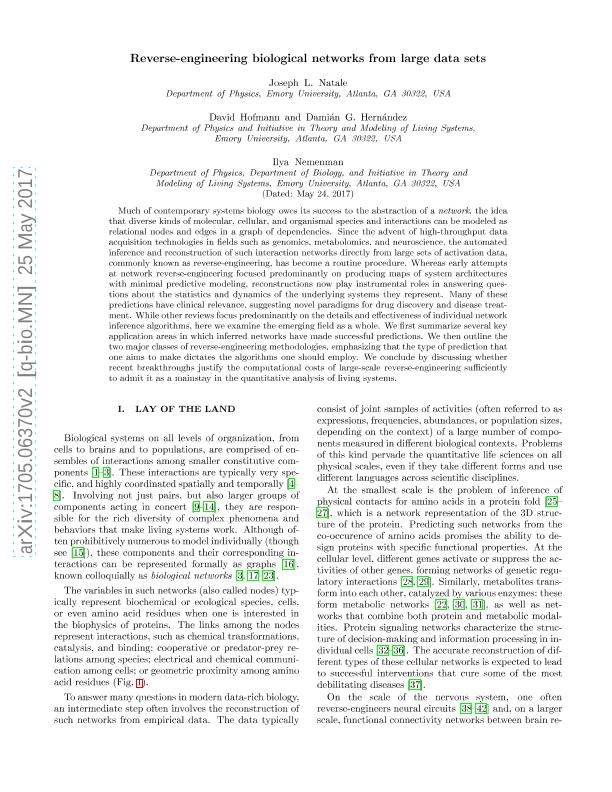Mostrar el registro sencillo del ítem
dc.contributor.author
Natale, Joseph J.
dc.contributor.author
Hofmann, David
dc.contributor.author
Hernández Lahme, Damián Gabriel

dc.contributor.author
Nemenman, Ilya
dc.contributor.other
Munsky, Brian
dc.contributor.other
Hlavacek, William S.
dc.contributor.other
Tsimring, Lev S.
dc.date.available
2021-08-11T13:40:51Z
dc.date.issued
2018
dc.identifier.citation
Natale, Joseph J.; Hofmann, David; Hernández Lahme, Damián Gabriel; Nemenman, Ilya; Reverse-engineering biological networks from large data sets; MIT Press; 2018; 213-246
dc.identifier.isbn
9780262038089
dc.identifier.uri
http://hdl.handle.net/11336/138143
dc.description.abstract
Much of contemporary systems biology owes its success to the abstraction of a network, the idea that diverse kinds of molecular, cellular, and organismal species and interactions can be modeled as relational nodes and edges in a graph of dependencies. Since the advent of high-throughput data-acquisition technologies in fields such as genomics, metabolomics, and neuroscience, the automated inference and reconstruction of such interaction networks directly from large sets of activation data, commonly known as reverse-engineering, has become a routine procedure. Whereas early attempts at network reverse-engineering focused predominantly on producing maps of system architectures with minimal predictive modeling, reconstructions now play instrumental roles in answering questions about the statistics and dynamics of the underlying systems they represent. Many of these predictions have clinical relevance, suggesting novel paradigms for drug discovery and disease treatment. While other reviews focus predominantly on the details and effectiveness of individual network inference algorithms, here we examine the emerging field as a whole. We first summarize several key application areas in which inferred networks have made successful predictions. We then outline the two major classes of reverse-engineering methodologies, emphasizing that the type of prediction that one aims to make dictates the algorithms one should employ. We conclude by discussing whether recent breakthroughs justify the computational costs of large-scale reverse-engineering sufficiently to admit it as a mainstay in the quantitative analysis of living systems.
dc.format
application/pdf
dc.language.iso
eng
dc.publisher
MIT Press

dc.rights
info:eu-repo/semantics/openAccess
dc.rights.uri
https://creativecommons.org/licenses/by-nc-sa/2.5/ar/
dc.subject
BIOLOGICAL
dc.subject
NETWORKS
dc.subject
INFERENCE
dc.subject
DATA
dc.subject.classification
Biofísica

dc.subject.classification
Ciencias Biológicas

dc.subject.classification
CIENCIAS NATURALES Y EXACTAS

dc.title
Reverse-engineering biological networks from large data sets
dc.type
info:eu-repo/semantics/publishedVersion
dc.type
info:eu-repo/semantics/bookPart
dc.type
info:ar-repo/semantics/parte de libro
dc.date.updated
2020-02-19T19:57:46Z
dc.journal.pagination
213-246
dc.journal.pais
Estados Unidos

dc.description.fil
Fil: Natale, Joseph J.. University of Emory; Estados Unidos
dc.description.fil
Fil: Hofmann, David. University of Emory; Estados Unidos
dc.description.fil
Fil: Hernández Lahme, Damián Gabriel. Consejo Nacional de Investigaciones Científicas y Técnicas. Centro Científico Tecnológico Conicet - Patagonia Norte; Argentina. Comisión Nacional de Energía Atómica. Gerencia del Area de Investigación y Aplicaciones No Nucleares. Gerencia de Física (Centro Atómico Bariloche); Argentina. University of Emory; Estados Unidos
dc.description.fil
Fil: Nemenman, Ilya. University of Emory; Estados Unidos
dc.relation.isreferencedin
info:eu-repo/semantics/reference/url/https://www.biorxiv.org/content/10.1101/142034v1
dc.relation.alternativeid
info:eu-repo/semantics/altIdentifier/url/https://mitpress.mit.edu/books/quantitative-biology
dc.relation.alternativeid
info:eu-repo/semantics/altIdentifier/url/https://arxiv.org/abs/1705.06370
dc.conicet.paginas
728
dc.source.titulo
Quantitative Biology: Theory, Computational Methods, and Models
Archivos asociados
